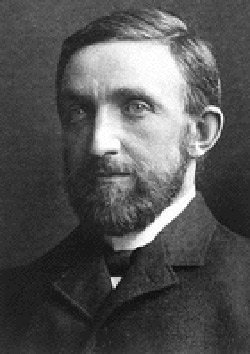Lenard, Philipp Eduard Anton (1862–1947)

Figure 1. Lenard's aparatus for determining e /
Philipp Lenard was a Hungarian-born German physicist awarded the 1905 Nobel Prize in Physics for his investigation of cosmic rays during which he showed that the atom is mostly empty space. He also made pioneering studies of the photoelectric effect, by which cathode rays (streams of electrons) are generated.
 |
Lenard and the photoelectric effect
The apparatus employed by Lenard for measuring the ratio of the mass to the charge for the ions emitted by a metal irradiated with ultraviolet light is shown in Figure 1. The apparatus is highly evacuated. Ultraviolet light, entering by the quartz window B, strikes an aluminum plate A. This is given a negative potential so that the negatively charged photo-ions which are liberated are repelled in a direction away from A towards the earthed electrode E, which has a small circular aperture. This aperture isolates a beam of the charged particles which falls upon the electrode D and is detected with an electrometer. A magnetic field can be applied with its lines of force perpendicular to the plane of the paper (the circle diagrammatically indicates the position of the pole-pieces), and when this is done, the ions traverse a circular path reaching the electrode C which records them.
In considering the forces acting upon the ions it will be at first assumed that any velocity imparted to them by the actual act of emission can be neglected. This being so, the ions will acquire a velocity v due only to the potential P applied between the electrodes A and E. If e and m are the charge and mass of the ions respectively, it follows that Pe = mv2/2. In the magnetic field, of strength H, the particles describe the arc of a circle of radius R given by R = vm/He. The radius can be calculated by measuring the distances of the electrodes C and D from the aperture E. Combining the two expressions gives elm = P/R2H2 and v = 2P/RH. The experiment showed that elm for the photo-ions was identical with that for the electron, thus it must be concluded that the photo-ions are electrons.
In Lenard's original experiment the applied voltage P was equal to 12,600 volts which, the above expression shows, gives the electrons a velocity of 5.4 × 109 centimeters per second.
It has been assumed that the initial velocity of ejection, if any, can be neglected and it is easy to show that with such a high applied voltage this is justified. The emission velocity can be measured directly by giving the electrode A a positive potential P0, which just suffices to cause the emitted electrons to return back to the electrode. Clearly P0 e = mv02/2 where v is the velocity acquired by the electrons due only to the act of photoelectric emission. In the particular experiment considered v0 was found to be equal to 108 centimeters per econds, which is only one-fiftieth of the velocity produced by the accelerating potential P and can thus be neglected, unless an accurate value of e/m is required. In practice it is convenient to describe the energy of electrons in electron volts. An electron in falling through a potential difference of 1 volt acquires a velocity of 5.9 × 107 centimeters per second.
With the apparatus just described Lenard made a very important discovery. He found that the emission velocity of the photoelectrons could vary from zero up to a maximum value, v0. The value of this maximum was independent of the intensity of the light, being affected only by the wavelength used and by the nature of the electrode A. He showed further that the number of emitted electrons is proportional to the intensity of the illumination. These two fundamental laws were applied by Einstein to the development of the quantum theory. Being of such importance, a critical re-examination was undertaken by Millikan with the object of testing the validity of the conclusions arrived at by Lenard on the basis of only approximately exact measurements. Millikan's experimental refinements enabled him to achieve a high degree of accuracy and the laws were completely vindicated.


